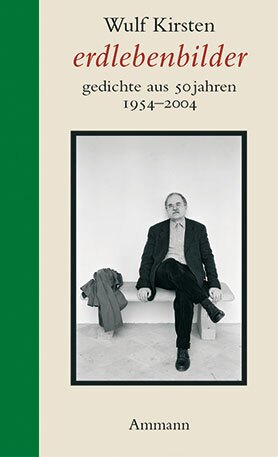Wulf Kirsten
Erdlebenbilder. Gedichte aus fünfzig Jahren 1954-2004. Mit einem Nachwort von Eberhard Haufe
[Pictures of earth life poems from fifty years 1954-2004. With an epilogue by Eberhard Haufe]
- Ammann Verlag
- Zurich 2004
- ISBN 3-250-10464-7
- 406 Pages
Sample translations
Review
Walter Benjamin distinguishes between two ideal types of storyteller. On the one hand, there are the settled farmers, who embody nearness. On the other hand, there are the travelling sailors, who represent distance. A true storyteller, according to Benjamin, is one who unites both of these ideal types. Wulf Kirsten is such a storyteller, even if his chosen form is poetry rather than fiction. His writing is as influenced by the wealth of experience of near objects, as it is by distance.
Born in Klipphausen in Saxony in 1934, Kirsten has always been a keen traveller. Due to the Cold War, his travels were largely reserved to the countries to the east of the GDR, such as Czechoslovakia, Poland and Romania. Not only did he explore their countryside, he also came to know their people and their stories. On such trips, pictures and memories were formed which in time found their way into his poetic world.
In the prose poem Luchian (1973), we hear of “The Sad Master Locksmith. Lorica. Safta’s Blossoming Life. The Abandoned Inn. The Cemetery Path. The Ox-cart. Drunk from the fountain at Brebu. Coloured in the Moineşti houses scattered on the hill like straw bales. The uprising, smothered in the blood of eleven thousand massacred farmers. The washerwoman’s leaden white. Fleecy bundles of flowers, shining like enamel, in Romanian jugs.” This poem, full of landscapes and events in Romania, was inspired by corresponding paintings by the Romanian painter Stefan Luchian (1868 – 1916), after whom the poem is named.
Interestingly, the poem deals with the technique used by the painter to capture atmosphere though telling details, as well as with the landscapes and historical events of the distant country. “The painter fixes the silvery grey mist in pastels, it rises in the twilight from the Chiajna meadows. A pulsating mass of colour, dipped in sun. Shades of green. Glowing constellations, which scream in anguish. Pain colours the calligraphy of flourished paint, like a suddenly wild wind in the leaves that carries everything off and buries it.” The poem observes Luchian’s paintings, both of landscapes and impressive and horrific events, and succeeds in transmitting all these aspects to the readers. Kirsten uses the artist’s techniques, but works with language rather than paints.
Furthermore, the technique that Kirsten the ‘sailor’ discovers in Luchian’s paintings, is the same method which Kirsten ‘the settled farmer’ employs in his lyrical representations of his home region. Forming a poetical world from the world of the farmers and tradesmen near his birthplace, he strives to bring them to life through words. As it says in the last two stanzas of his 1967 poem satzanfang (Starting a Sentence), which can be seen as a statement of his artistic intentions:
[. . .]
fervently naming them: the villagers,
their resilience, their workday patience.
From figures of speech erecting statues
of a dynasty of smallholders
whose names suggested little.
Down the flow of words in light reflected
off the oaten yellow flanks
of my promised land. I put
its rough, furrowed earth
into words.
The naming, the putting into words, is a central concern for Kirsten. Reading his poems, one has the impression that not only his technique for capturing reality, as described earlier, but also his way of observing things is very similar to a painter’s. His poems often spring from visual impressions, for example, Flats on a Sunday (1977) or The Swing (1990). Kirsten’s poems are remarkably precise in their observation, which – as he himself says – is “a crucial requirement if you are to represent the countryside as clearly and as true to life as possible.”
Kirsten’s collected poems, Pictures of Earth Life, was published this year by Ammann Verlag on the occasion of his seventieth birthday. Its title can certainly be seen as a defining statement. For Wulf Kirsten is indeed a painter of words, often using words that seem to come from a distant or long forgotten past, such as ‘windrows’, the threshing machine’s ‘feeding board’ and the baker’s ‘peel’. In this regard too, Kirsten’s written pictures share a function with paintings; they conserve. In his poems, words are not just stored. They are brought to life again in astounding combinations.
The starting point and central focus of his poetry are the countryside of his home region and the people who live there. Poems such as The Earth at Meissen and Seven Sentences about my Village are proof of this. However, Kirsten is not interested in an idyllic praising and poeticising of country life. With his techniques of naming and listing, he does not aim to conjure up a magical landscape, but describe objects as exactly as he can. His “promised land” has become a “rough, furrowed earth” and a “wasteland”, “where nothing grows which is of use in farming” and which is full of “closed gravel pits, where nature has a free hand.” Instead of the once “fertile arable land” only a “wild reef” can be seen.
Not idealising the countryside in his poetry, Kirsten instead roots it in its civilisation and history. His poetry is anything but escapist; rather, he joins the tradition of critical nature poets such as Peter Huchel, Günter Eich and Johannes Bobrowski, who called into question the traditional concept of nature poetry. They made our wronging of nature a theme of their poetry by including our destruction of nature in their poems. Kirsten is every bit as much a chronicler of his times as his literary influences and like-minded contemporaries. He not only remembers and retains in his poetry the slowly dying world of his childhood, he also mourns its loss.
Fifty years are a long time, perhaps particularly in the formation of a literary œvre. Pictures of Earth Life, which collects a good 250 poems from this period, on the one hand documents Kirsten’s formal and thematic development, while yet displaying his steadfastness and his determination to stay true to himself. In this way, he has created a painterly memorial to his own and to many a foreign countryside, as well as to himself.

Born in Klipphausen in Saxony in 1934, Kirsten has always been a keen traveller. Due to the Cold War, his travels were largely reserved to the countries to the east of the GDR, such as Czechoslovakia, Poland and Romania. Not only did he explore their countryside, he also came to know their people and their stories. On such trips, pictures and memories were formed which in time found their way into his poetic world.
In the prose poem Luchian (1973), we hear of “The Sad Master Locksmith. Lorica. Safta’s Blossoming Life. The Abandoned Inn. The Cemetery Path. The Ox-cart. Drunk from the fountain at Brebu. Coloured in the Moineşti houses scattered on the hill like straw bales. The uprising, smothered in the blood of eleven thousand massacred farmers. The washerwoman’s leaden white. Fleecy bundles of flowers, shining like enamel, in Romanian jugs.” This poem, full of landscapes and events in Romania, was inspired by corresponding paintings by the Romanian painter Stefan Luchian (1868 – 1916), after whom the poem is named.
Interestingly, the poem deals with the technique used by the painter to capture atmosphere though telling details, as well as with the landscapes and historical events of the distant country. “The painter fixes the silvery grey mist in pastels, it rises in the twilight from the Chiajna meadows. A pulsating mass of colour, dipped in sun. Shades of green. Glowing constellations, which scream in anguish. Pain colours the calligraphy of flourished paint, like a suddenly wild wind in the leaves that carries everything off and buries it.” The poem observes Luchian’s paintings, both of landscapes and impressive and horrific events, and succeeds in transmitting all these aspects to the readers. Kirsten uses the artist’s techniques, but works with language rather than paints.
Furthermore, the technique that Kirsten the ‘sailor’ discovers in Luchian’s paintings, is the same method which Kirsten ‘the settled farmer’ employs in his lyrical representations of his home region. Forming a poetical world from the world of the farmers and tradesmen near his birthplace, he strives to bring them to life through words. As it says in the last two stanzas of his 1967 poem satzanfang (Starting a Sentence), which can be seen as a statement of his artistic intentions:
[. . .]
fervently naming them: the villagers,
their resilience, their workday patience.
From figures of speech erecting statues
of a dynasty of smallholders
whose names suggested little.
Down the flow of words in light reflected
off the oaten yellow flanks
of my promised land. I put
its rough, furrowed earth
into words.
The naming, the putting into words, is a central concern for Kirsten. Reading his poems, one has the impression that not only his technique for capturing reality, as described earlier, but also his way of observing things is very similar to a painter’s. His poems often spring from visual impressions, for example, Flats on a Sunday (1977) or The Swing (1990). Kirsten’s poems are remarkably precise in their observation, which – as he himself says – is “a crucial requirement if you are to represent the countryside as clearly and as true to life as possible.”
Kirsten’s collected poems, Pictures of Earth Life, was published this year by Ammann Verlag on the occasion of his seventieth birthday. Its title can certainly be seen as a defining statement. For Wulf Kirsten is indeed a painter of words, often using words that seem to come from a distant or long forgotten past, such as ‘windrows’, the threshing machine’s ‘feeding board’ and the baker’s ‘peel’. In this regard too, Kirsten’s written pictures share a function with paintings; they conserve. In his poems, words are not just stored. They are brought to life again in astounding combinations.
The starting point and central focus of his poetry are the countryside of his home region and the people who live there. Poems such as The Earth at Meissen and Seven Sentences about my Village are proof of this. However, Kirsten is not interested in an idyllic praising and poeticising of country life. With his techniques of naming and listing, he does not aim to conjure up a magical landscape, but describe objects as exactly as he can. His “promised land” has become a “rough, furrowed earth” and a “wasteland”, “where nothing grows which is of use in farming” and which is full of “closed gravel pits, where nature has a free hand.” Instead of the once “fertile arable land” only a “wild reef” can be seen.
Not idealising the countryside in his poetry, Kirsten instead roots it in its civilisation and history. His poetry is anything but escapist; rather, he joins the tradition of critical nature poets such as Peter Huchel, Günter Eich and Johannes Bobrowski, who called into question the traditional concept of nature poetry. They made our wronging of nature a theme of their poetry by including our destruction of nature in their poems. Kirsten is every bit as much a chronicler of his times as his literary influences and like-minded contemporaries. He not only remembers and retains in his poetry the slowly dying world of his childhood, he also mourns its loss.
Fifty years are a long time, perhaps particularly in the formation of a literary œvre. Pictures of Earth Life, which collects a good 250 poems from this period, on the one hand documents Kirsten’s formal and thematic development, while yet displaying his steadfastness and his determination to stay true to himself. In this way, he has created a painterly memorial to his own and to many a foreign countryside, as well as to himself.
Translated by Stefan Tobler

By Chalit Durongphan
